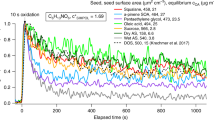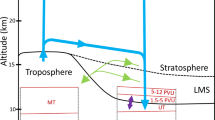Abstract
Arising from: G. Israël et al. Nature 438, 796–799 (2005); Israël et al. reply
On 14 January 2005, the Huygens probe entered the atmosphere of Titan after a seven-year interplanetary flight as part of the Cassini mission to Saturn. Huygens carried, among other instruments, an aerosol collection and pyrolysis (ACP) device1. Its designers, Israël et al.2, now claim to have detected complex organic matter in two aerosol samples collected at different altitudes (130–35 km and 25–20 km, respectively), on the basis of their detection of ammonia (NH3) and hydrogen cyanide (HCN) when the sample oven was heated to 600 °C. However, the authors' remarkable conclusions, which would have far-reaching consequences for our understanding of the chemical environment prevailing on Saturn's largest moon, are not supported by their limited data.
Similar content being viewed by others
Main
The claim by Israël et al.2 to have detected NH3 is based on the signal they obtain at a mass-to-charge ratio (m/z) of 17 in the 18 mass spectra (see their Fig. 3) recorded for sample 2 after the sample oven had been heated to 600 °C and swept with an isotope of nitrogen (15N2). However, with a single exception (at 10:57:27), these signals can be accounted for by methane containing 13C (that is, 13CH4), as calculation from the signal at m/z 16 (12CH4) and the 12C/13C ratio (82.3) of Titan's atmospheric methane indicates3; sample 1 apparently produced similar results2. Considering the small signals and large error bars indicated in Fig. 3 of ref. 2, it is not valid to conclude that ammonia has been detected in these experiments.
The claim by Israël et al.2 that HCN could be detected is also unsupported by their data. The signal for m/z 27 in the mass spectrum for sample 1 is the same as that from the background (their Fig. 1) and, as the authors point out, the small peak in the spectrum for sample 2 (their Fig. 2) may well be a fragment of ethane or ethylene. The signals above m/z 27 of these known constituents of Titan's atmosphere are obliterated by those from the large amounts of light (m/z 28, 29) and heavy nitrogen (m/z 30).
These two spectra are dominated by signals at m/z 16, 28 and 40, which correspond to the components of the atmosphere (CH4, 14N2 and 40Ar). This may have entered the sample cavity through the leaking gaskets, which had caused the loss of all data from the “ambient” and 250 °C experiments2 (see section 2 and Fig. 4 of the supplementary information accompanying ref. 2). These leaks would also explain the increase in the signals for sample 2, because it was collected at lower altitude (higher pressure). There is therefore no compelling evidence that any aerosol was collected or that anything was pyrolysed in these experiments.
What the authors mean by the “complex organic matter” they claim to have detected in Titan's atmospheric aerosols is illustrated in their supplementary Fig. 6: a remarkable, detailed structure, consisting of an aromatic and a cyclohexane ring, connected and substituted by several linear and branched aliphatic chains, bearing one amino, two imino and two nitrile groups. Even though this is designated as a “probable” structure, it is not justified on the basis of the authors' dubious evidence for the presence of NH3 and HCN.
Compounds of this type would pyrolyse to small unsaturated aliphatic and aromatic molecules. Benzene and its homologues are easy to detect by mass spectrometry at very low levels owing to their aromaticity. They give rise to abundant molecular ions at m/z 78 and 78 + 14n, respectively, which is well within the mass range (m/z 2–142) of the mass spectrometer aboard the Huygens probe3. To explain their absence, Israël et al. suggest that the spectrometer has low sensitivity above m/z 50.
To justify the extrapolation from NH3 and HCN to complex organic matter of the type shown in their supplementary Fig. 6, Israël et al.2 rely on laboratory analogues (tholins) of Titan's aerosols. These have been produced in various laboratories ever since data from Voyager's 1980 fly-by of Titan showed that its atmosphere consists of nitrogen and a few per cent of methane. Irradiation of such mixtures with various energy sources invariably produced some amorphous materials1,4,5,6, but these were only crudely characterized and not even partially separated for structural analysis. In support of their assertion that such a tholin on pyrolysis produces only NH3 and HCN (but nothing else), the authors show a gas chromatogram in their supplementary Fig. 1. However, that figure shows only the region from about 2–10 min of the 60-min chromatogram, cutting off just after the emergence of HCN at 9.35 min, beyond which many other pyrolysis products are likely to emerge1,5. The claim to have detected complex organic matter in Titan's atmospheric haze is therefore further undermined.
Other data obtained from the successful Cassini–Huygens mission contradict or correct some previously held notions about Titan, its origin and its environment3,7,8. The idea that the observed haze must be due to aerosol particles consisting of large organic molecules of complex structure needs to be re-evaluated. The chemical nature of the haze on Titan still remains shrouded in mystery.
Change history
04 June 2018
This article was published with the same DOI as a previous publication. A new DOI has been assigned and registered at Crossref, and has been corrected in the article.
References
Israël, G. et al. Space Sci. Rev. 104, 435–466 (2002).
Israël, G. et al. Nature 438, 796–799 (2005).
Niemann, H. et al. Nature 438, 779–784 (2005).
Khare, B. N. et al. Adv. Space Res. 4, 59–68 (1984).
Coll, P., Coscia, D., Gazeau, M.-C., Guez, L. & Raulin, F. Orig. Life Evol. Biosph. 28, 195–213 (1997).
Somogyu, A., Oh, C.-H., Smith, M. A. & Lunine, J. I. J. Am. Soc. Mass Spectrom. 16, 850–859 (2005).
Porco, C. C. et al. Nature 434, 159–168 (2005).
Zarnecki, J. C. et al. Nature 438, 792–795 (2005).
Author information
Authors and Affiliations
Rights and permissions
About this article
Cite this article
Biemann, K. Complex organic matter in Titan's aerosols?. Nature 444, E6 (2006). https://doi.org/10.1038/nature05417x
Published:
Issue Date:
DOI: https://doi.org/10.1038/nature05417x
Comments
By submitting a comment you agree to abide by our Terms and Community Guidelines. If you find something abusive or that does not comply with our terms or guidelines please flag it as inappropriate.



